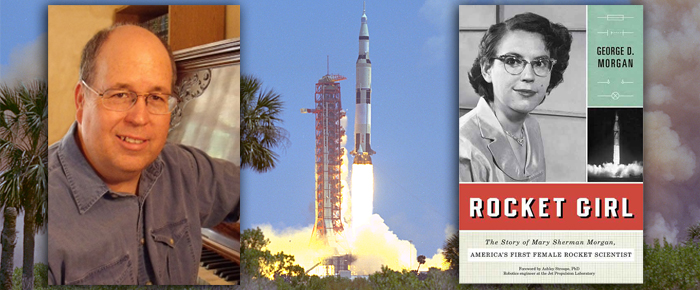
By Heidi Simmons
How well do you think you know your parents? As kids we often get a narrow representation of who our folks really are. It’s certainly a challenge to know their past and sometimes it’s unclear what they do for a living. For author George D. Morgan, the image of his mother only recently came into focus while writing his book Rocket Girl: The Story of Mary Sherman Morgan America’s First Female Rocket Scientist (Prometheus Books, 325).
“Growing up I thought my mother was an average American housewife who fixed spaghetti on Thursday nights, went to church on Sunday, watched the Ed Sullivan Show and played Bridge,” said Morgan. “I had a normal childhood. But I have no memory of my mother ever going to work.” Morgan’s mother did go to work. She had top-secret clearance at North American Aviation where she invented the rocket fuel that launched America’s first satellite into orbit.
At the UCR Arts and Letters Series last week, Morgan talked about his book and mother with Tod Goldberg, UCR MFA Program Director. Morgan is a student in the program working on his creative writing graduate degree. Morgan is also a playwrite and screenwriter. The conversation between Morgan and Goldberg was particularly interesting. Goldberg was especially curious about the mystery and relationship of the author and his mother. No doubt, for Goldberg, the mother issue is something very relatable.
“I grew up with her, she was my mother, but I really knew nothing about her until after she passed away. Ninety-nine percent of what I know about her, I learned from her friends and coworkers after she died,” Morgan said. “I’m still uncovering new information every day from people who are contacting me. She was a true enigma, who held many secrets and lead a fascinating life.”
Mary Sherman Morgan worked for North American Aviation for seven years. She quit after her youngest child was born in 1957. She died in 2004 at the age of 84. It was at her funeral that a coworker of hers suggested to the author that he needed to tell his mother’s story. This presented a challenge for Morgan. Only five of his mother’s coworkers were still alive.
Of the nine hundred employees working at North American Aviation, Mary Sherman Morgan was the only woman scientist. Even more incredible, Mary Morgan had no college degrees – none. She worked as an analyst, but she was actually a chemist. Her contribution was the invention and development of a rocket fuel called Hydyne. It was the fuel used to launch the Redstone rocket that carried America’s first satellite.
The author had to do a forensic investigation to find anything about his mother and the process has had its challenges. Hardly anything existed on her work or contribution at NAA. “My parents never talked about anything,” Morgan said. “She wasn’t a close person. She wasn’t the kind of mother that put her arms around you and said I love you.” His mother never even helped with his chemistry homework.
Richard Columbus attended the event. A retired North American Aviation engineer, Columbus work at the same facility as Morgan’s mother from 1962 to 1966 five years after Mary Morgan quit.
“It doesn’t make sense to me,” Columbus said. “We had an in-house publication where the work being done was shared. There were company logs where you recorded everything you were doing with the date and time. And the company allowed co authorship on patents.” Columbus was not convinced Mary Morgan invented the Hydyne rocket fuel or even worked at North American Aviation. He also said that the years he was at NAA, there was not one woman scientist employed.
There is still a lot Morgan is learning. He found out from a late night call that his mother had a child out of wedlock. Mary Morgan was a devout Catholic. He was not the firstborn, but the second. He contacted his half-sister, who knew very little about her biological mother or father. This is what makes Rocket Girl an even more fascinating subject. Like NAA, Mary Sherman Morgan had her secrets and kept them.
For the author, his goal is clear. He wants his mother to get the credit where the credit is due. His book, part history, part memoir and part mystery has made that mission a success.












































